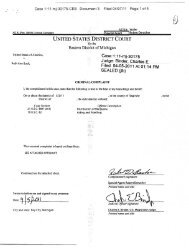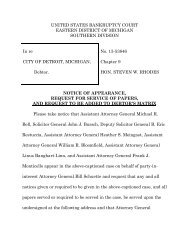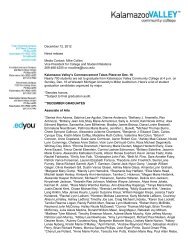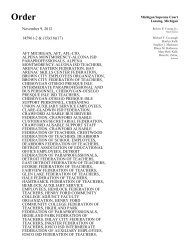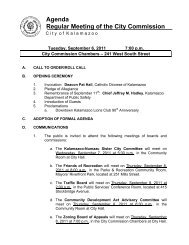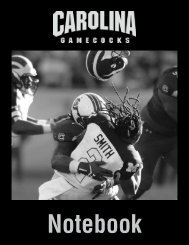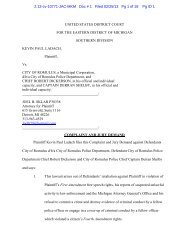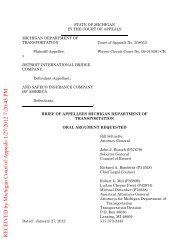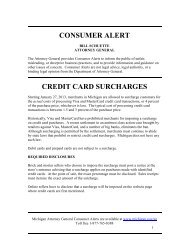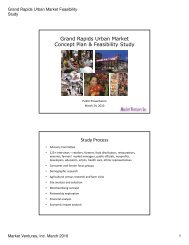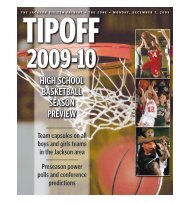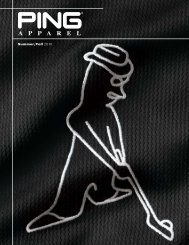muskegon county kindergarten readiness checklist - MLive.com
muskegon county kindergarten readiness checklist - MLive.com
muskegon county kindergarten readiness checklist - MLive.com
You also want an ePaper? Increase the reach of your titles
YUMPU automatically turns print PDFs into web optimized ePapers that Google loves.
MUSKEGON COUNTY KINDERGARTEN READINESS CHECKLIST<br />
CHILD’S NAME: PRESCHOOL CLASS: Head Start GSRP Tuition<br />
ECSE<br />
PRESCHOOL TEACHER:<br />
CONTACT NUMBER:<br />
Scale: 1 = Not Ready 2 = Periodic Readiness (Demonstrates less than 50% proficiency) 3 = Approaching<br />
Readiness (Demonstrates proficiency in majority of the descriptors and is developing proficiency in others) 4 =<br />
Ready<br />
APPROACHES TO LEARNING:<br />
The manner in which a child works with<br />
others and approaches tasks and learning<br />
leads to the development of critical<br />
executive skills for both school and life.<br />
Displays persistence in task<br />
Demonstrates initiative in learning<br />
Works cooperatively with others<br />
Comprehends and follows directions<br />
Shows self-confidence in contributing<br />
to classroom learning<br />
SOCIAL-EMOTIONAL<br />
DEVELOPMENT: How a child forms<br />
relationships, regulates and expresses<br />
emotions, and develops his or her personal<br />
identity are core <strong>com</strong>ponents to<br />
<strong>kindergarten</strong> <strong>readiness</strong>.<br />
Forms healthy relationships with peers<br />
and adults<br />
Recognizes and manages emotions<br />
Adjusts to transitions<br />
Focuses attention on activity, project,<br />
or task<br />
PHYSICAL HEALTH AND<br />
DEVELOPMENT: Physical wellbeing<br />
and motor development impact a<br />
child’s <strong>readiness</strong> to learn.<br />
Completes basic self-care tasks<br />
independently<br />
Coordinates eye-hand movement to<br />
perform tasks<br />
Demonstrates basic gross motor skills<br />
in a wide range of physical activities<br />
Child is attentive, focused, resilient, and successfully manages frustrations when<br />
<strong>com</strong>pleting projects/tasks.<br />
Child participates, asks questions, is self-directed, and demonstrates<br />
imagination, curiosity, and “risk-taking” in experiencing new things.<br />
Child interacts easily with others. Child shares, helps others, and cooperates in<br />
small and large groups.<br />
Child listens to and follows simple rules in individual, small and large group<br />
activities. Child demonstrates an ability to carry out a set of three directions.<br />
Child is not afraid to voice an opinion, initiate conversation, or contribute to the<br />
classroom’s overall learning environment.<br />
Child makes friends, interacts with others in a positive manner by sharing,<br />
helping others, taking turns, etc. Child forms close relationships with adults,<br />
especially with parents and family members.<br />
Child controls impulses, expresses a variety of emotions, resolves conflict<br />
without harming others, and recognizes and responds to the feelings of others.<br />
Child adapts to new environments and choices with appropriate behaviors and<br />
emotions, separates from parents or caregiver calmly, and transitions between<br />
activities without major disruption.<br />
Child is able to self-regulate behaviors and emotions in order to stay focused on<br />
task and listen to others. Focusing attention for at least 10 minutes during circle<br />
time is expected.<br />
Child eats, dresses, washes hands, and uses toilet facilities by self.<br />
Child easily uses blocks, beads, puzzles, utensils, writing tools, etc.<br />
Child moves with balance and control. Child uses gross motor skills aid in<br />
performing some of the following: Skip, jump, hop, throw, catch, kick, ride a
Possesses the strength, dexterity, and<br />
control in small muscles to use tools for<br />
writing and drawing<br />
Attends to health status<br />
LANGUAGE DEVELOPMENT:<br />
Language development opens a child’s<br />
world to <strong>com</strong>munication and social<br />
interaction and assists learning across all<br />
child development domains.<br />
Able to engage in conversations with<br />
peers and adults<br />
Understands and uses an increasingly<br />
varied vocabulary<br />
Uses language to express feelings and<br />
needs<br />
Uses effective listening skills<br />
EARLY LITERACY: Early literacy<br />
serves as the foundation for reading and<br />
writing in future school years and life.<br />
Recognizes words as a unit of print<br />
and understands that letters are<br />
grouped to form words<br />
Uses written shapes, symbols, pictures,<br />
letters, and words to convey meaning<br />
Demonstrates beginning phonemic<br />
awareness<br />
Identifies the letters within and writes<br />
their first name<br />
Displays interest in and enjoys reading<br />
Comprehends and responds to fiction<br />
and non-fiction texts<br />
EARLY MATHEMATICS: Math<br />
skills help young children develop both<br />
logical and abstract thinking skills as well<br />
as to nurture analytical thought.<br />
Shows understanding of number and<br />
quantity<br />
Demonstrates basic knowledge of<br />
positional concepts and words<br />
Sorts objects including recognizing<br />
patterns<br />
Uses number concepts and operations<br />
to solve problems<br />
tricycle, etc.<br />
Child effectively uses fine motor skills to successfully manipulate objects such<br />
as pencils, crayons, and scissors.<br />
Child has access to medical care, receives well-child exams and treatment of<br />
chronic condition(s), and gets adequate rest, nutrition, and exercise to support<br />
healthy development.<br />
Child regularly engages in conversation. Child initiates and responds<br />
appropriately in one-on-one and group discussions, speaks clearly, conveys<br />
ideas, and tells stories.<br />
Child understands what is said to him/her and has developed an age-appropriate<br />
vocabulary increasing in <strong>com</strong>plexity.<br />
Child expresses oneself with words and expanded sentences. Child is able to<br />
manage conflict by using words.<br />
Child demonstrates an ability and willingness to learn by watching and listening<br />
to others.<br />
Child understands that letters are <strong>com</strong>bined to create words and can identify a<br />
few familiar words in written form, such as their name.<br />
Child experiments with a variety of writing tools and understands that writing is<br />
a way to <strong>com</strong>municate information, share stories, etc. Child has an emerging<br />
knowledge of reading and writing concepts such as “top-down” and “left-toright.”<br />
Child recognizes and produces simple rhyming words and is beginning to<br />
identify beginning and ending sounds in words.<br />
Child identifies the letters of their first name as well as beginning letters of a<br />
few familiar words.<br />
Child independently looks at a book with purpose and uses reading-like<br />
behaviors. Child enjoys shared reading experiences. Family member(s) engage<br />
in reading experiences with their child on an ongoing basis.<br />
Child demonstrates an understanding of what they hear in stories through<br />
subsequent conversation, artistic work, drama, etc. Child retells information<br />
from books in sequence.<br />
Child understands numbers represent order and quantity and can count objects<br />
to at least 10, preferably 20. Child knows that numbers are added or subtracted<br />
to form new numbers.<br />
Child <strong>com</strong>prehends positional concepts such as “up/down, before/after,<br />
under/over, top/bottom, less/more, small/smaller/smallest, big/bigger/biggest,”<br />
etc.<br />
Child is able to identify and sort objects by color, size, or shape. Child<br />
recognizes duplicates and begins to identify & extend patterns.<br />
Child shows ability to classify, <strong>com</strong>pare, measure, and contrast objects in<br />
analyzing a problem or task, thus displaying an understanding of beginning<br />
math concepts beyond basic counting.
Comments:



